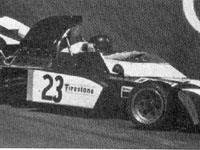If only F1 had come to Brazil sooner...
Author
- Mattijs Diepraam
Date
- 8W April 1999 issue, additional information by Carlos de Paula on September 21, 2002
Related articles
- Berta - The Grand Prix car Argentina almost had, by Mattijs Diepraam/Felix Muelas/Nicolas Korzan/Hans Swart
- John Surtees - A natural on two and four wheels, by Mattijs Diepraam
Who?Luis Pereira Bueno What?Surtees-Cosworth TS9B Where?Interlagos When?1973 Brazilian GP |
 |
Why?
Suppose you're a head hunter scouting for future F1 talent - where would you go if you want to have an easy life? Bet you would take the first flight to Brazil. Every winter, hordes of fast and furious young Brazilians come over to Europe to swamp the old continent's championships, their nationality seemingly an advantage on its own in getting the best European (and Japanese) drives around. In fact, just about every leading international championship today has a Brazilian title contender.
This of course begs the question - where do they all come from? Today, in motorsport terms, Brazil is almost synonymous for natural speed, and to the historically challenged, it's always been like that. But before Emerson Fittipaldi's sudden rise to fame the centre of gravity in South American motorsport was pulling everyone to Argentina. In the fifties - apart from F1's most successful driver Juan Manuel Fangio - Froilan Gonzalez, Onofre Marimón, Roberto Mieres and Carlos Menditeguy were household names in F1, with Argentina hosting several F Libre "Temporada" races during the off-season. All Brazil could put up against this influx of Argentinian fast men were the likes of Chico Landi, Nano da Silva Ramos and Gino Bianco - hardly talent to set the world on fire.
Fittipaldi changed it all. While Carlos Reutemann has been the only noteworthy driver to come from the Pampas since from the time Emerson Fittipaldi made his stunning debut, Brazil snatched up a further six titles to quadruple Fitti's tally of two.
In 1972, the first Brazilian Grand Prix was held to acknowledge the increased attention for the local favourite. Ironically, the non-championship race was won by Reutemann, the last of the great Argentinians. For next season, with Fittipaldi crowned champion, Interlagos was on the F1 calendar proper. This time, Emmo was a much celebrated winner, paving the ground for other Brazilian drivers, of whom Carlos Pace seemed to have the brightest future in store.
Especially for Interlagos, Pace had a one-time team mate in a third-car entry. A local hero in the true Emilio de Villota mould, Luis Pereira Bueno's complete F1 career has been captured by this single photograph. Although an F1 part-timer because of age and budget, his lower-category record looks the part. In 1969, he scored five wins in European FF1600, driving a Merlyn, continuing in national racing in 1970, taking two championships in all: the 1972 Brazilian Sportscar Championship and the 1975 Division 4 Championship. The first he took racing a Porsche 908/3, the same car that he used in the Österreichring 1000kms in 1972. Division 4 was another sports-prototype championship, the difference being that only Brazilian built cars were allowed, thus ruling out the 908/3. Notwithstanding, the rules were bent a few times, and oddities such as a Brazilian-engined Ford GT40 and a Chevrolet-engined Royale were seen on track. Making use of this loophole, Bueno's team commissioned a car from Argentinian touring-car wizard Oreste Berta and put in it a Brazilian Ford... Maverick-engined, and admittedly chock-full of American components. The car was miles ahead of the competition and essentially killed sportscar racing in Brazil until the late 90s.
Bueno did race a Ford Maverick in Touring cars in 1975 but lost the championship to Paulo Gomes, who also raced at Le Mans and in British F3 in 1976.
Bueno's F1 debut came at the 1972 non-championship event at Interlagos, where he finished a creditable 6th in the No.12 March entry, partnering Ronnie Peterson in the works team. He outqualified Marko and Soler-Roig to line up 10th, and with Pace, Pescarolo and Gethin out on lap 1, he was able to finish in the top six. For 1973, it was a totally different story, Bueno taking out the ageing TS9B-005 chassis driven by Hailwood the previous year. This time, Luis was a staggering 12 seconds slower than pole man and erstwhile team mate Peterson, even granted the fact this was at the old Interlagos track with its long and twisty infield section still intact. All the same, to Ronnie's pole time of 2.30'5 Bueno left a gap of nearly 8 percent, so in today's world Bueno would have sat out Sunday as a DNQ. To his credit, Bueno kept running and finished the race, albeit hitting rock-bottom in the final classification, 4 laps down on Fittipaldi, and trailing his nearest competitor by two laps.
This was to be the penultimate appearance of the TS9B, three years after the original TS9 Grand Prix car was launched. At the next race at Kyalami, Andrea De Adamich replaced Bueno as a third entry and drove a TS9B for the final time.
